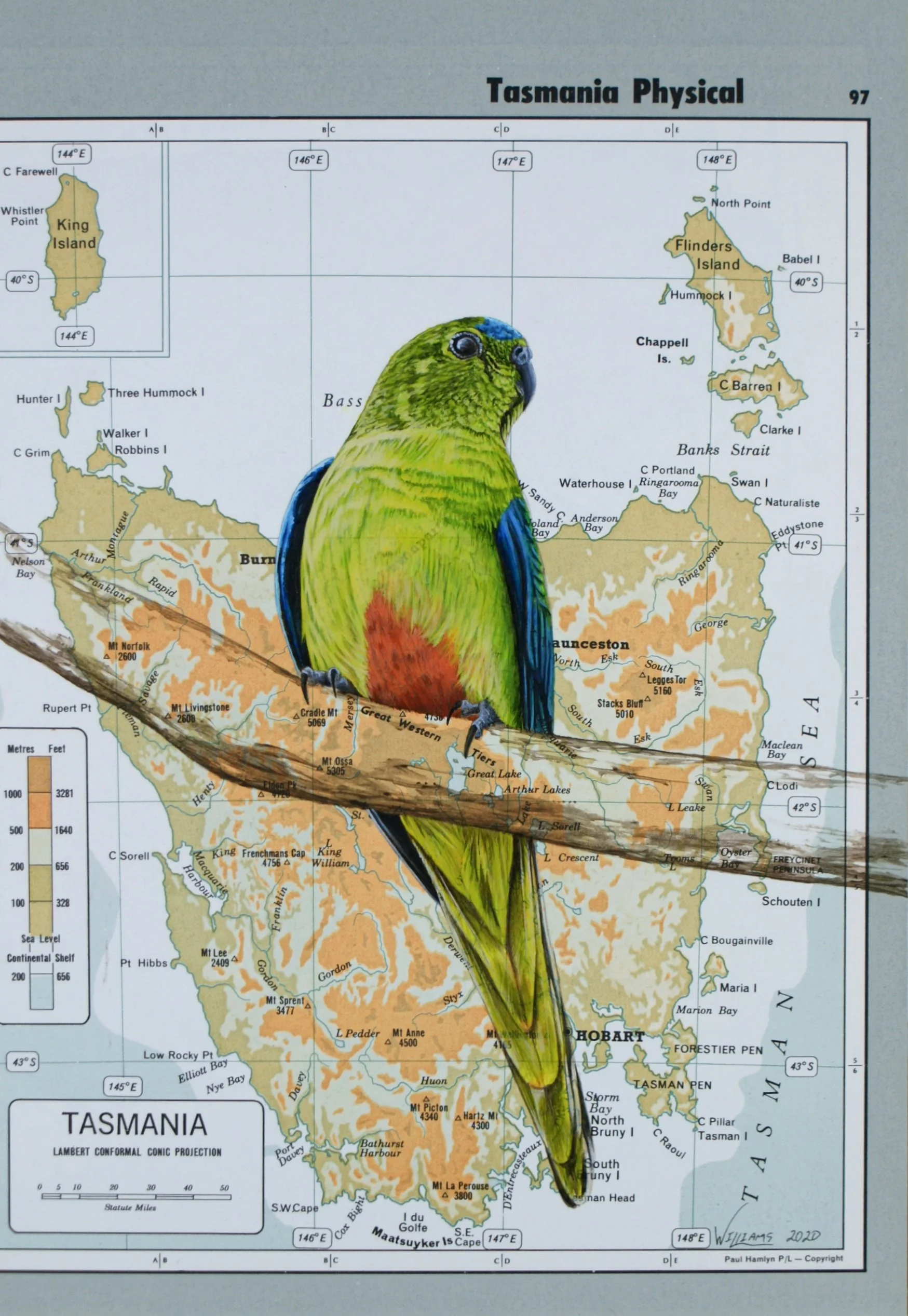
Craig Williams Eastern Meadowlark, acrylic

Craig Williams Blue Jay, acrylic

Craig Williams Hooded Plover, acrylic

Craig Williams Orange Bellied Parrot, acrylic

Craig Williams Pink Robin, acrylic

Craig Williams Scarlet Robin, acrylic
Craig Williams
Craig Williams paints images of birds on vintage book pages, maps, and sheet music to convey a deeper sense of a bird’s history, territory, and characteristics
There’s an unmistakable appeal to vintage books, leafing through decades-old pages to discover fresh inspiration. Combine that with a masterful bird painting on a vintage page, and you have a remarkable piece of art that transcends its materials — art that speaks to the depth and history of both the book and the subject.
This is what Australian artist Craig Williams accomplishes with his well-loved bird paintings that use pages from out-of-print field guides, maps, and sheet music as the backgrounds for his work. He’ll often choose a field guide page detailing a specific bird species, then paint the bird in layers of acrylic paint, transforming the book page into the background of a stunning piece of art.
Williams uses sheet music as the background to songbird paintings to communicate the relationship between a bird and the beauty of its song. And he’ll paint birds on maps to show their territories, deepening the viewer’s understanding of the bird he’s painting.
Finding the Right Vintage Book
“I love the hunt for old books; it’s really a bit of the thrill of the hunt to find just the right volume and interior pages,” says Williams. “In fact, flicking through a book, looking at chapters and subjects within, can actually drive the inspiration for a piece.”
An example of this was when Williams found a series of books about construction techniques needed for building small dams. “That immediately sparked the idea that, since these dams are critical for the survival of migratory waterbirds, I could paint images of those waterbirds onto the books’ pages. So the book can absolutely inspire the piece.”
A Scientific Background
A self-taught artist, Williams’ work has evolved through the years. “Early on I used to go for drawing or painting every hair or feather in my art, but my style now has a more natural sort of feel to it, where a brushstroke is just a bit of paint that gives the impression of feathers or the details on a bird. But I’m still always going for a certain level of realism,” he says.
His background in zoology and his experience creating scientific illustrations of fossils, dinosaurs, and insects (even a series on spider genetalia), became the basis for the details seen in his wildlife paintings today.
Slow Painting Approach with Acrylics
Once Williams chooses a page, he removes it from the book and glues it to archival matt board with acid-free spray glue. He’s found that Golden Open Slow Drying Acrylics, mixed 50/50 with glazing medium, lets him build color by applying several semi-transparent layers. This paint mixture also lets him use wet-on-wet techniques for color blending and gradation.
“Painting in a lot of thin, translucent layers allows colors to be seen through each other, which enhances a painting’s vibrancy,” Williams explains. “It also allows for little sneak peeks of letters from the book page to show through the painting itself which strengthens the relationship between the page and the painted bird. When you sit back and look at those snippets of letters, they actually contribute further detail to a painting. It’s a really nice effect that just happens during the evolution of a piece.”
In terms of composition, Williams plays with the placement of birds on the pages, often placing images off-center or using the branch a bird is perched on to activate the negative space surrounding the subject to create interest and tension in the artwork.
Williams has participated in exhibitions throughout Tasmania, Australia (his home), and has private collectors across Australia, in the U.S., Canada, New Zealand, Spain, Italy, Germany, and the U.K. He also creates traditional paintings of particular bird species in collaboration with the podcast, “The Science of Birds,” with 50 percent of the proceeds from the sale of his work donated to bird conservation projects around the world.
All images © Craig Williams, shared with permission.

